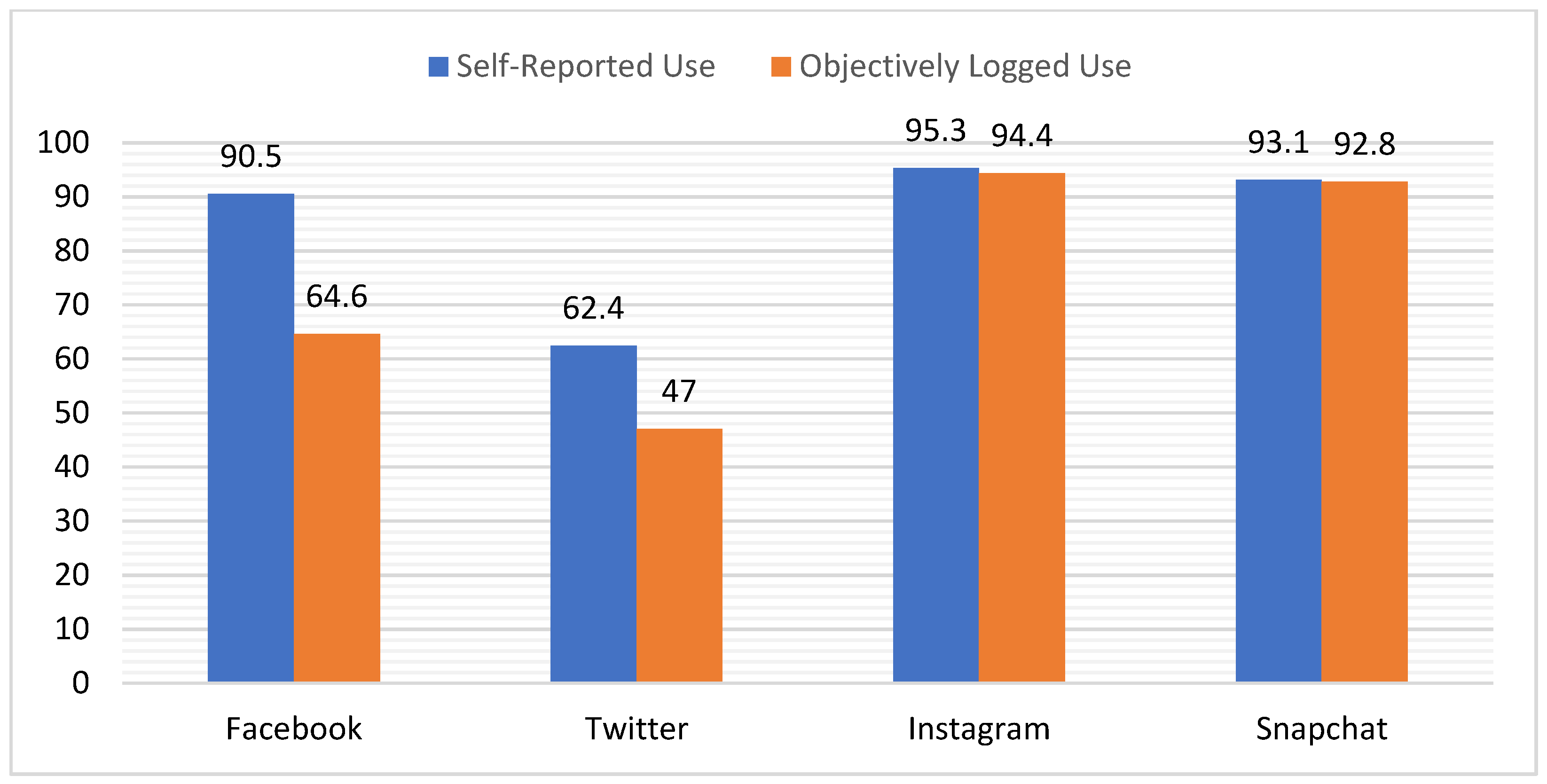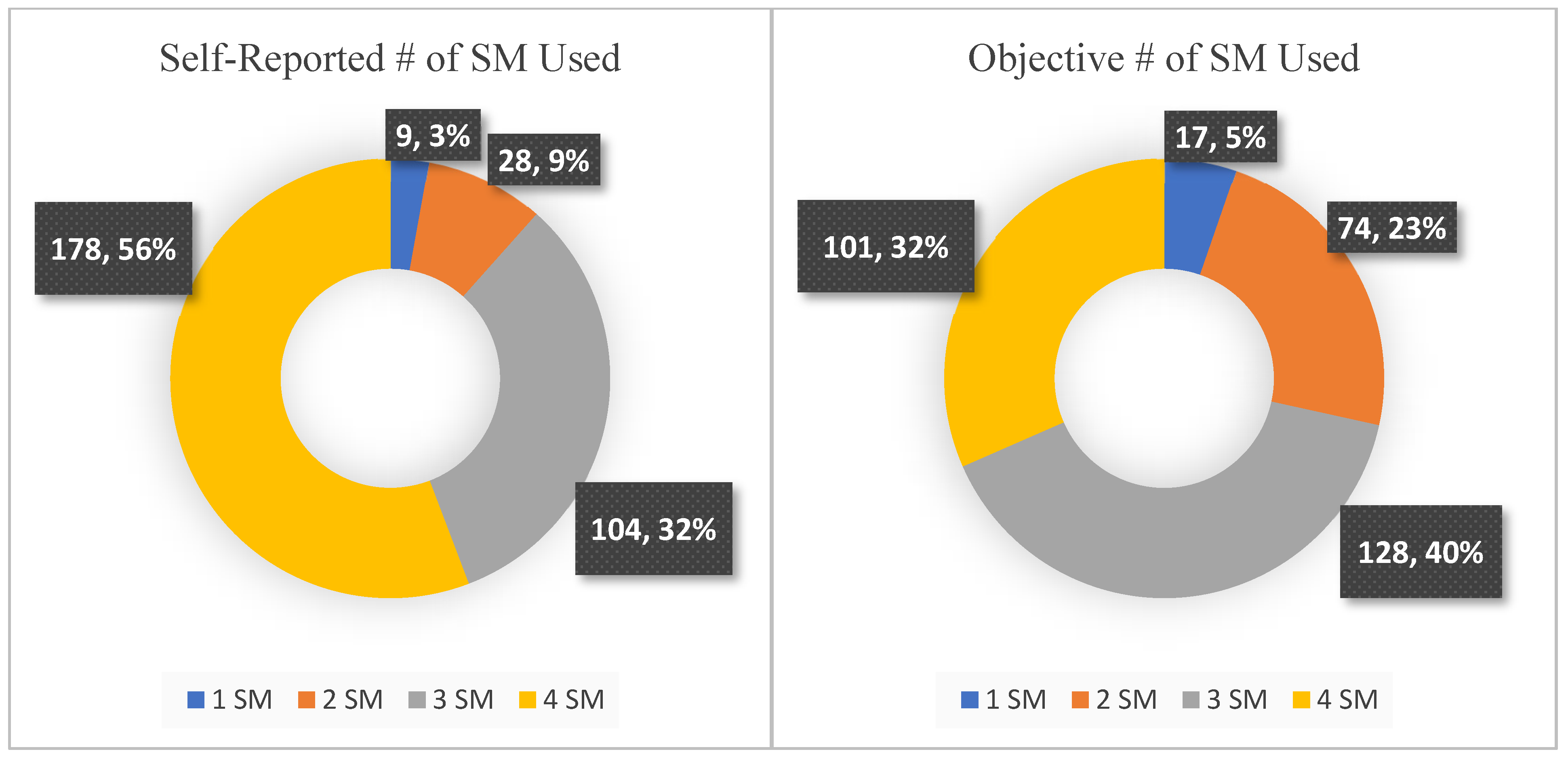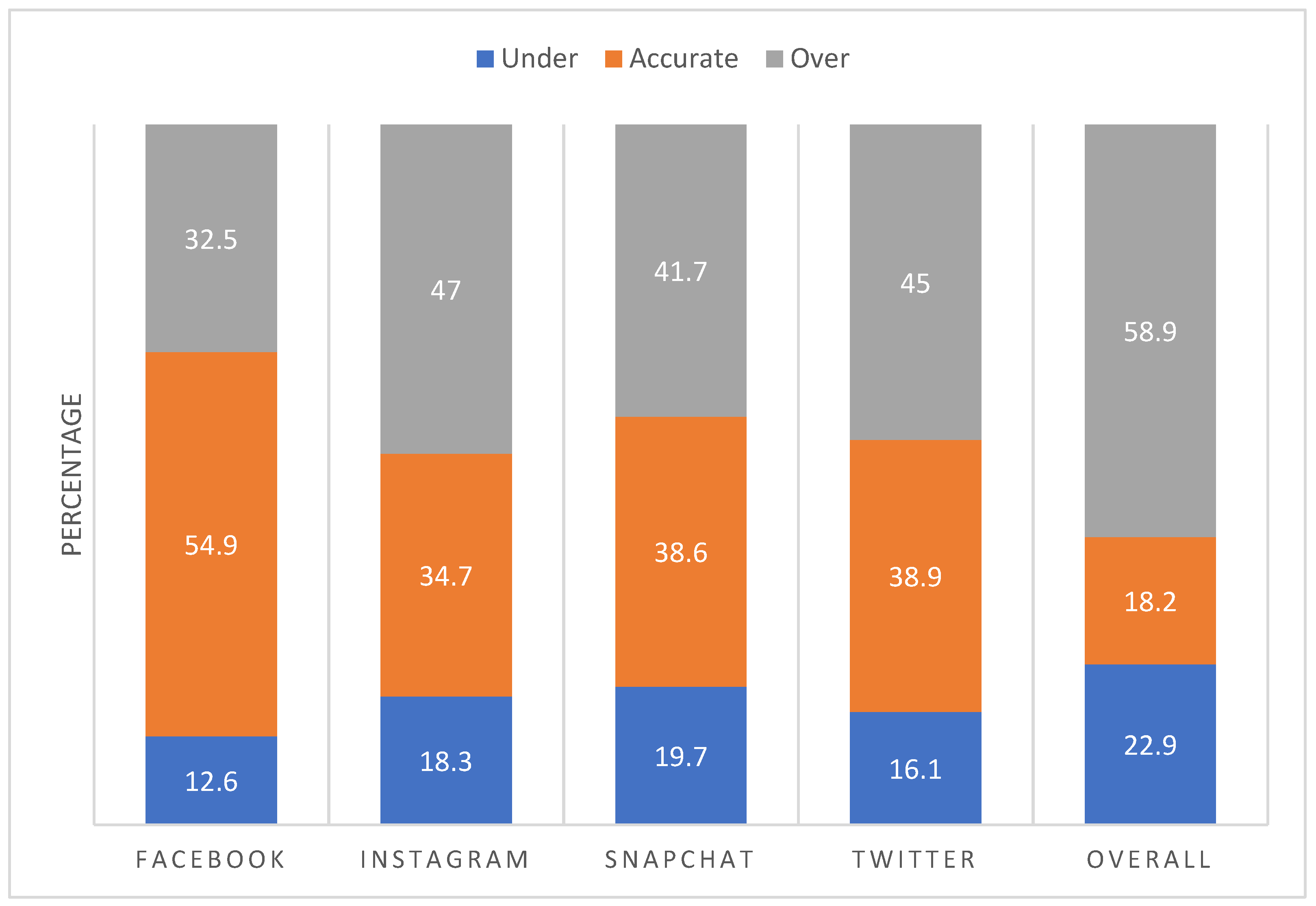Systematic Bias in Self-Reported Social Media Use in the Age of Platform Swinging: Implications for Studying Social Media Use in Relation to Adolescent Health Behavior
Abstract
:1. Introduction
1.1. Previous Research and Limitations
1.2. Explanations for Reporting Inaccuracy and Potential Systematic Predictors
1.2.1. SM Platform
1.2.2. Reporter Sex
1.2.3. SM Platform Swinging
1.3. The Current Study
2. Methods and Materials
2.1. Participants
2.2. Recruitment and Study Procedures
2.3. Measures
2.3.1. Demographics
2.3.2. Objective Daily Time on SM
2.3.3. Supplemental Battery Screen Data (iPhone Owners Only)
2.3.4. Self-Reported Platform Use and Daily SM Time
2.4. Analytic Plan
3. Results
3.1. Preliminary Analysis
3.2. Accuracy of Self-Reported Daily SM Time (H1)
3.3. Major versus Minor Inaccuracies in Self-Report Overall (H2) and by SM Platform (H3)
3.4. Is Sex (H4) or # of SM Used (H5) Related to Likelihood of Over/Under-Estimation?
4. Discussion
4.1. Implications for Researchers Studying Social Media Use among Adolescents
4.2. Limitations and Future Directions
5. Conclusions
Author Contributions
Funding
Institutional Review Board Statement
Informed Consent Statement
Data Availability Statement
Conflicts of Interest
References
- Jarman, H.K.; Marques, M.D.; McLean, S.A.; Slater, A. Motivations for social media use: Associations with social media engagement and body satisfaction and well-being among adolescents. J. Youth Adolesc. 2021, 50, 2279–2293. [Google Scholar] [CrossRef] [PubMed]
- Phua, J.; Jin, S.V.; Kim, J. Uses and gratifications of social networking sites for bridging and bonding social capital: A comparison of Facebook, Twitter, Instagram, and Snapchat. Comput. Hum. Behav. 2017, 72, 115–122. [Google Scholar] [CrossRef]
- Tandoc, E.C.; Lou, C.; Min VL, H. Platform-swinging in a poly-social-media context: How and why users navigate multiple social media platforms. J. Comput.-Mediat. Commun. 2019, 24, 21–35. [Google Scholar] [CrossRef]
- Ivie, E.J.; Pettitt, A.; Moses, L.J.; Allen, N.B. A meta-analysis of the association between adolescent social media use and depressive symptoms. J. Affect. Disord. 2020, 275, 165–174. [Google Scholar] [CrossRef]
- Lin, L.; Sidani, J.E.; Shensa, A.; Radovic, A.; Miller, E.; Colditz, J.B.; Hoffman, B.L.; Giles, L.M.; Primack, B.A. Association between social media use and depression among U.S. young adults. Depress. Anxiety 2016, 33, 323–331. [Google Scholar] [CrossRef]
- Marengo, D.; Longobardi, C.; Fabris, M.A.; Settanni, M. Highly-visual social media and internalizing symptoms in adolescence: The mediating role of body image concerns. Comput. Hum. Behav. 2018, 82, 63–69. [Google Scholar] [CrossRef]
- Yang, H.; Wang, J.J.; Tng, G.Y.Q.; Yang, S. Effects of social media and smartphone use on body esteem in female adolescents: Testing a cognitive and affective model. Children 2020, 7, 148. [Google Scholar] [CrossRef]
- Alonzo, R.; Hussain, J.; Stranges, S.; Anderson, K.K. Interplay between social media use, sleep quality, and mental health in youth: A systematic review. Sleep Med. Rev. 2021, 56, 101414. [Google Scholar] [CrossRef]
- Levenson, J.C.; Shensa, A.; Sidani, J.E.; Colditz, J.B.; Primack, B.A. The association between social media use and sleep disturbance among young adults. Prev. Med. 2016, 85, 36–41. [Google Scholar] [CrossRef] [Green Version]
- Hormes, J.M. Under the influence of Facebook? Excess use of social networking sites and drinking motives, consequences, and attitudes in college students. J. Behav. Addict. 2016, 5, 122–129. [Google Scholar] [CrossRef] [Green Version]
- Ng Fat, L.; Cable, N.; Kelly, Y. Associations between social media usage and alcohol use among youths and young adults: Findings from Understanding Society. Addiction 2021, 116, 2995–3005. [Google Scholar] [CrossRef]
- Perkins, J.M.; Perkins, H.W.; Craig, D.W. Misperceived norms and personal sugar-sweetened beverage consumption and fruit and vegetable intake among students in the United States. Appetite 2018, 129, 82–93. [Google Scholar] [CrossRef] [PubMed]
- Litt, D.M.; Rodriguez, L.M.; Stewart, S.H. Examining associations between social networking site alcohol-specific social norms, posting behavior, and drinking to cope during the Covid-19 pandemic. Cyberpsychol. Behav. Soc. Netw. 2021, 24, 715–721. [Google Scholar] [CrossRef] [PubMed]
- Perasso, G.; Carone, N.; Health Behavior in School Aged Children Lombardy Group; Barone, L. Written and visual cyberbullying victimization in adolescence: Shared and unique associated factors. Eur. J. Dev. Psych. 2021, 18, 658–677. [Google Scholar] [CrossRef]
- Johannes, N.; Nguyen, T.; Weinstein, N.; Przybylski, A.K. Objective, subjective, and accurate reporting of social media use: No evidence that daily social media use correlates with personality traits, motivational states, or well-being. Technol. Mind Behav. 2021, 2, 1–14. [Google Scholar] [CrossRef]
- Anderson, M.; Jiang, J. Teens, Social Media & Technology 2018; Pew Research Center: Washington, DC, USA, 2018; Available online: https://www.pewresearch.org/internet/2018/05/31/teens-social-media-technology-2018/ (accessed on 8 December 2021).
- Villanti, A.C.; Johnson, A.L.; Ilakkuvan, V.; Jacobs, M.A.; Graham, A.L.; Rath, J.M. Social media use and access to digital technology in US young adults in 2016. J. Med. Internet Res. 2017, 18, e7303. [Google Scholar] [CrossRef] [PubMed]
- Junco, R. Comparing actual and self-reported measures of Facebook use. Comput. Hum. Behav. 2013, 29, 626–631. [Google Scholar] [CrossRef]
- Ernala, S.K.; Burke, M.; Leavitt, A.; Ellison, N.B. How well do people report time spent on Facebook? An evaluation of established survey questions with recommendations. In Proceedings of the 2020 CHI Conference on Human Factors in Computing Systems; ACM Digital Library: New York, NY, USA, 2020; pp. 1–14. [Google Scholar] [CrossRef]
- Sewall, C.J.; Bear, T.M.; Merranko, J.; Rosen, D. How psychosocial well-being and usage amount predict inaccuracies in retrospective estimates of digital technology use. Mob. Media Commun. 2020, 8, 379–399. [Google Scholar] [CrossRef]
- LaBrie, J.W.; Trager, B.M.; Boyle, S.C.; Davis, J.P.; Earle, A.M.; Morgan, R.M. An examination of the prospective associations between objectively assessed exposure to alcohol-related Instagram content, alcohol-specific cognitions, and first-year college drinking. Addict. Behav. 2021, 119, 106948. [Google Scholar] [CrossRef]
- Blackstone, S.; Russie, C. Using Instagram to deliver a theory-based wellness intervention designed to promote behavior change. Eur. J. Public Health 2020, 30, ckaa166-008. [Google Scholar] [CrossRef]
- Vogel, E.A.; Ramo, D.E.; Meacham, M.C.; Prochaska, J.J.; Delucchi, K.L.; Humfleet, G.L. The put it out project (POP) Facebook intervention for young sexual and gender minority smokers: Outcomes of a pilot, randomized, controlled trial. Nicotine Tob. Res. 2020, 22, 1614–1621. [Google Scholar] [CrossRef] [PubMed]
- Dodou, D.; de Winter, J.C. Social desirability is the same in offline, online, and paper surveys: A meta-analysis. Comput. Hum. Behav. 2014, 36, 487–495. [Google Scholar] [CrossRef]
- Durmaz, A.; Dursun, İ.; Kabadayi, E.T. Mitigating the effects of social desirability bias in self-report surveys: Classical and new techniques. In Applied Social Science Approaches to Mixed Methods Research; IGI Global: Hershey, PA, USA, 2020; pp. 146–185. [Google Scholar] [CrossRef]
- Ward, M.K.; Meade, A.W. Applying social psychology to prevent careless responding during online surveys. Appl. Psychol. 2018, 67, 231–263. [Google Scholar] [CrossRef] [Green Version]
- Hill, N.L.; Mogle, J.; Whitaker, E.B.; Gilmore-Bykovskyi, A.; Bhargava, S.; Bhang, I.Y.; Van Haitsma, K. Sources of response bias in cognitive self-report items: Which memory are you talking about? Gerontologist 2019, 59, 912–924. [Google Scholar] [CrossRef]
- Weaver, P.; Choi, J.; Kaufman, T. Question wording and response bias: Students’ perceptions of ethical issues in the hospitality and tourism industry. J. Hosp. Tour. Educ. 1997, 9, 21–26. [Google Scholar] [CrossRef]
- Brenner, P.S. Overreporting of voting participation as a function of identity. Soc. Sci. J. 2012, 49, 421–429. [Google Scholar] [CrossRef]
- Brenner, P.S. Narratives of response error from cognitive interviews of survey questions about normative behavior. Sociol. Methods Res. 2017, 46, 540–564. [Google Scholar] [CrossRef]
- Brenner, P.S.; DeLamater, J. Lies, damned lies, and survey self-reports? Identity as a cause of measurement bias. Soc. Psychol. Q. 2016, 79, 333–354. [Google Scholar] [CrossRef] [Green Version]
- Auxier, B.; Anderson, M. Social Media Use in 2021; Pew Research Center: Washington, DC, USA, 2021; Available online: https://www.pewresearch.org/internet/2021/04/07/social-media-use-in-2021/ (accessed on 8 December 2021).
- Boyle, S.C.; Earle, A.M.; LaBrie, J.W.; Ballou, K. Facebook dethroned: Revealing the more likely social media destinations for college students’ depictions of underage drinking. Addict. Behav. 2017, 65, 63–67. [Google Scholar] [CrossRef] [Green Version]
- Hoelzel, M. Update: A breakdown of the Demographics for Each of the Different Social Networks; Business Insider: New York, NY, USA, 2015; Available online: http://www.businessinsider.com/update-a-breakdown-of-the-demographics-for-each-of-the-different-social-networks-2015-6 (accessed on 8 December 2021).
- Neal, R.W. Facebook Gets Older: Demographic Report Shows 3 Million Teens Left Social Network in 3 Years. International Business Times. 2014. Available online: http://www.ibtimes.com/facebook-gets-older-demographic-report-shows-3-million-teens-left-social-network-3-years-1543092 (accessed on 8 December 2021).
- Schwarz, N.; Oyserman, D. Asking questions about behavior: Cognition, communication, and questionnaire construction. Am. J. Eval. 2001, 22, 127–160. [Google Scholar] [CrossRef] [Green Version]
- Tourangeau, R.; Rips, L.J.; Rasinski, K. The Psychology of Survey Response; Cambridge University Press: Cambridge, UK, 2000. [Google Scholar] [CrossRef]
- Gramlich, J. 10 Facts about Americans and Facebook; Pew Research Center: Washington, DC, USA, 2019; Available online: https://www.pewresearch.org/fact-tank/2019/05/16/facts-about-americans-and-facebook/ (accessed on 8 December 2021).
- Djafarova, E.; Rushworth, C. Exploring the credibility of online celebrities’ Instagram profiles in influencing the purchase decisions of young female users. Comput. Hum. Behav. 2016, 68, 1–7. [Google Scholar] [CrossRef]
- Lim, Y.J. Decision to use either Snapchat or Instagram for Most Powerful Celebrities. Res. J. Inst. Public Relat. 2017, 3, 1–16. [Google Scholar]
- Bányai, F.; Zsila, Á.; Király, O.; Maraz, A.; Elekes, Z.; Griffiths, M.D.; Demetrovics, Z. Problematic social media use: Results from a large-scale nationally representative adolescent sample. PLoS ONE 2017, 12, e0169839. [Google Scholar] [CrossRef] [Green Version]
- Knight-McCord, J.; Cleary, D.; Grant, N.; Herron, A.; Jumbo, S.; Lacey, T.; Livingston, T.; Robinson, S.; Smith, R.; Emanuel, R. What social media sites do college students use most? J. Undergrad. Ethn. Minority Psychol. 2016, 2, 6. [Google Scholar]
- Madden, M.; Zickuhr, K. 65% of Online Adults Use Social Networking Sites: Women Maintain Their Foothold on SNS Use and Older Americans are still Coming Aboard; Pew Research Centrer: Washington, DC, USA, 2021; Available online: https://www.pewresearch.org/internet/2011/08/26/65-of-online-adults-use-social-networking-sites/ (accessed on 8 December 2021).
- Muscanell, N.L.; Guadagno, R.E. Make new friends or keep the old: Gender and personality differences in social networking use. Comput. Hum. Behav. 2012, 28, 107–112. [Google Scholar] [CrossRef]
- Park, N.; Lee, H. Gender difference in social networking on smartphones: A case study of Korean college student smartphone users. Int. Telecommun. Policy Rev. 2014, 21, 1–18. [Google Scholar]
- Deng, T.; Kanthawala, S.; Meng, J.; Peng, W.; Kononova, A.; Hao, Q.; David, P. Measuring smartphone usage and task switching with log tracking and self-reports. Mob. Media Commun. 2019, 7, 3–23. [Google Scholar] [CrossRef]
- Lee, H.; Ahn, H.; Nguyen, T.G.; Choi, S.-W.; Kim, D.J. Comparing the self-report and measured smartphone usage of college students: A pilot study. Psychiatry Investig. 2017, 14, 198–204. [Google Scholar] [CrossRef]
- LaBrie, J.W.; Boyle, S.C.; Young, S.H.; Tan, C.N. Prospective relationships between objectively assessed social media use, drinking norms, and alcohol consumption among first-year students. J. Stud. Alcohol Drugs 2021, 82, 339–350. [Google Scholar] [CrossRef]
- Andreassen, C.; Billieux, J.; Griffiths, M.; Kuss, D.; Demetrovics, Z.; Mazzoni, E.; Pallesen, S. The relationship between addictive use of social media and video games and symptoms of psychiatric disorders: A large-scale cross-sectional study. Psychol. Addict. Behav. 2016, 30, 252–262. [Google Scholar] [CrossRef] [Green Version]
- Van den Eijnden, R.J.; Lemmens, J.S.; Valkenburg, P.M. The social media disorder scale. Comp. Hum. Behav. 2016, 61, 478–487. [Google Scholar] [CrossRef] [Green Version]



| Overall (N = 319) | Males (N = 121) | Females (N = 198) | |
|---|---|---|---|
| M (SD) | M (SD) | M (SD) | |
| Objective Measure | |||
| Facebook A | 11.49 (18.26) ***C, D | 10.34 (20.51) | 12.19 (16.75) |
| Twitter B | 14.32 (33.65) ***C, D | 14.25 (29.01) | 14.36 (36.20) |
| Instagram C | 34.42 (37.49) ***A, B | 27.60 (28.12) | 38.58 (41.71) |
| Snapchat D | 41.75 (43.09) ***A, B | 35.65 (36.43) | 45.46 (46.37) |
| Total SM | 101.99 (91.70) | 87.84 (75.85) | 110.60 (99.32) |
| Self-Report Measure | |||
| Facebook A | 18.28 (30.12) ***C, D | 17.00 (29.58) | 19.07 (30.49) |
| Twitter B | 20.69 (32.75) ***C, D | 18.93 (29.35) | 21.76 (34.69) |
| Instagram C | 49.96 (52.12) ***A, B | 31.56 (27.82) | 61.21 (59.82) |
| Snapchat D | 57.51 (68.08) ***A, B | 42.31 (43.18) | 66.80 (78.21) |
| Total SM | 146.38 (129.54) | 109.80 (87.01) | 168.74 (145.44) |
| Meandiff | |||
| Facebook A | −6.83 (28.62) *** | −6.65 (27.76) ** | −6.93 (29.21) *** |
| Twitter B | −6.34 (35.68) ** | −4.70 (28.89) | −7.34 (39.29) ** |
| Instagram C | −15.53 (55.28) *** | −3.95 (29.72) | −22.60 (65.28) *** |
| Snapchat D | −15.98 (65.10) *** | −6.66 (37.25) | −21.67 (76.87) *** |
| Total SM | −44.60 (137.79) *** | −21.95 (78.50) ** | −58.45 (162.44) *** |
| Overall | By Sex | |||
|---|---|---|---|---|
| R | R Males | R Females | Z Sex Rdiff | |
| 0.39 *** | 0.43 *** | 0.35 *** | 0.81 | |
| 0.42 *** | 0.51 *** | 0.38 *** | 1.39 | |
| 0.27 *** | 0.44 *** | 0.21 ** | 2.22 ** | |
| Snapchat | 0.32 *** | 0.57 *** | 0.32 *** | 2.70 ** |
| All SM | 0.26 *** | 0.54 *** | 0.16 * | 3.79 *** |
| Platform | Outcome | Predictors | OR | 95% CI [OR] |
|---|---|---|---|---|
| Under-estimator | Female Sex | 0.89 | 0.39–2.03 | |
| Number of SM platforms used | 1.01 | 0.59–1.72 | ||
| Over-estimator | Female Sex | 1.36 | 0.79–2.33 | |
| Number of SM platforms used | 0.96 | 0.69–1.35 | ||
| Under-estimator | Female Sex | 1.08 | 0.44–2.67 | |
| Number of SM platforms used | 6.07 ** | 2.14–17.21 | ||
| Over-estimator | Sex | 1.19 | 0.67–2.13 | |
| Number of SM platforms used | 7.94 ** | 4.10–15.37 | ||
| Under-estimator | Female Sex | 1.22 | 0.64–2.31 | |
| Number of SM platforms used | 1.06 | 0.72–1.57 | ||
| Over-estimator | Sex | 2.15 ** | 1.29–3.59 | |
| Number of SM platforms used | 1.51 ** | 1.08–2.10 | ||
| Snapchat | ||||
| Under-estimator | Female Sex | 1.92 * | 1.01–3.64 | |
| Number of SM platforms used | 1.69 * | 1.08–2.66 | ||
| Over-estimator | Female Sex | 2.26 ** | 1.35–3.79 | |
| Number of SM platforms used | 1.43 * | 1.03–2.00 | ||
| Total SM | ||||
| Under-estimator | Sex | 1.28 | 0.63–2.58 | |
| Number of SM platforms used | 1.38 | 0.91–2.08 | ||
| Over-estimator | Sex | 1.43 | 0.78–2.62 | |
| Number of SM platforms used | 1.82 ** | 1.26–2.60 |
Publisher’s Note: MDPI stays neutral with regard to jurisdictional claims in published maps and institutional affiliations. |
© 2022 by the authors. Licensee MDPI, Basel, Switzerland. This article is an open access article distributed under the terms and conditions of the Creative Commons Attribution (CC BY) license (https://creativecommons.org/licenses/by/4.0/).
Share and Cite
Boyle, S.C.; Baez, S.; Trager, B.M.; LaBrie, J.W. Systematic Bias in Self-Reported Social Media Use in the Age of Platform Swinging: Implications for Studying Social Media Use in Relation to Adolescent Health Behavior. Int. J. Environ. Res. Public Health 2022, 19, 9847. https://doi.org/10.3390/ijerph19169847
Boyle SC, Baez S, Trager BM, LaBrie JW. Systematic Bias in Self-Reported Social Media Use in the Age of Platform Swinging: Implications for Studying Social Media Use in Relation to Adolescent Health Behavior. International Journal of Environmental Research and Public Health. 2022; 19(16):9847. https://doi.org/10.3390/ijerph19169847
Chicago/Turabian StyleBoyle, Sarah C., Sebastian Baez, Bradley M. Trager, and Joseph W. LaBrie. 2022. "Systematic Bias in Self-Reported Social Media Use in the Age of Platform Swinging: Implications for Studying Social Media Use in Relation to Adolescent Health Behavior" International Journal of Environmental Research and Public Health 19, no. 16: 9847. https://doi.org/10.3390/ijerph19169847
APA StyleBoyle, S. C., Baez, S., Trager, B. M., & LaBrie, J. W. (2022). Systematic Bias in Self-Reported Social Media Use in the Age of Platform Swinging: Implications for Studying Social Media Use in Relation to Adolescent Health Behavior. International Journal of Environmental Research and Public Health, 19(16), 9847. https://doi.org/10.3390/ijerph19169847






